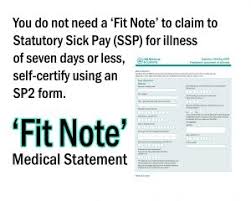Statutory Sick Pay (SSP)
The current rate of Statutory Sick Pay (SSP) is £95.85 per week in the United Kingdom. Your employer must pay it for a period of up to 28 weeks if you are unable to work through illness.
So, how do you qualify for SSP (paid time off from work)? First of all, you must have been away from work sick for at least four (4) days in a row (which can also include non-working days).
Your employer cannot pay you less than the statutory amount. Even so, you could get more if your company operates a sick pay scheme (called an ‘occupational scheme’).
How can you check if your employer is running an occupational scheme? If they are, the terms and conditions will be stated in your employment contract.
Statutory Sick Pay Rates 2020
The last increase in Statutory Sick Pay (SSP) saw the weekly rate rise to £95.85 for 2020. The payments can continue for a maximum of 28 weeks.
Providing you meet the eligibility criteria, you get SSP for all the qualifying days (i.e. period of incapacity for work). The definition of a ‘qualifying day’ is one where you would usually have worked – but you are off sick.
In most cases, you would not get paid for the first three days (called ‘waiting days’). You would only get paid for waiting days if you already received SSP in the previous eight (8) weeks and it included a 3-day waiting period.
How is Statutory Sick Pay Paid?
Employers should pay SSP to their employees in the same way as they pay normal wages (e.g. weekly or monthly). Similarly, as an employee your employer will also deduct tax and National Insurance from the payment.
Disputes about Statutory Sick Pay
Always discuss the issue with your employer if you feel you are not getting the right amount. If that fails to solve the dispute you should contact the HM Revenue and Customs enquiry line (details below).
Statutory Sick Pay Eligibility
So, how do you qualify for Statutory Sick Pay (SSP)? You must be classed as an employee (already carried out some work for your employer) and:
- Have been off work ill for at least four (4) consecutive days (including non-working days).
- Be earning at least £120 per week (as an average for at least eight weeks).
- Notify your employer you are sick before the company deadline (within seven days if they do not have one).
SSP Exceptions
As an employee, you would not qualify for Statutory Sick Pay if you:
- Already received the maximum amount (28 weeks).
- Are getting Statutory Maternity Pay (SMP) or Maternity Allowance.
- Were on strike or in custody on the first day of sickness (including any linked periods).
- Received Employment and Support Allowance (ESA) within 12 weeks of starting or returning to work.
What if you recently started a job and you have less than eight weeks of pay? In this case, you may still qualify. Discuss it with your employer to get further information.
Rules for Linked Periods of Sickness
SSP rules change if you have regular periods of sickness (e.g. linked). Consequently, the definition of linked periods of sickness are periods that:
- Last for four (4) or more days.
- Are no more than eight (8) weeks apart.
Even so, having a continuous series of linked periods that last for more than three (3) years would make you no longer eligible for Statutory Sick Pay.
Proof of Sickness (Fit Notes)
You do NOT need to give your employer a fit note unless you are off work sick for more than seven (7) days in a row (including non-working days).

Your GP or a hospital doctor can give you a fit note (when required).
A physiotherapist, podiatrist, or occupational therapist can also issue sick notes (called an Allied Health Professionals report).
But, your employer would need to agree to you giving them an AHP document.
What Happens When You Can’t Get SSP?
If your SSP has ended, or you do not qualify for it, you might get Employment and Support Allowance (ESA) or be able to apply for Universal Credit instead.
You should use form SSP1 to support this kind of application. If your SSP payment is going to end your employer must send form SSP1 to you (either):
- Within seven (7) days of it ending (e.g. if it ends unexpectedly while you are off work sick).
- No later than the beginning of the 23rd week (e.g. if it is expected to end before the sickness will).
How to Claim Statutory Sick Pay 2020
Different employers and companies have different policies for reporting time off work through illness. But, you must tell your employer by their particular deadline (or 7 days) to get Statutory Sick Pay (SSP).
Talk to your employer if you are unsatisfied with a decision or if you think they are not paying you the correct amount of sickness pay.
Your employer should give you a reason to justify their decision. If it fails to solve the problem, you should contact the statutory payment dispute team at HM Revenue and Customs.
HMRC Statutory Payment Dispute Team
Telephone: 03000 560 630
Monday to Thursday: 8:30am to 5pm
Friday: 8:30am to 4:30pm
Textphone users can contact the HM Revenue and Customs (HMRC) employees’ enquiry line.
HMRC Employees’ Enquiry Line
Textphone: 0300 200 3212
Monday to Friday: 8am to 5pm
Find out more on call charges